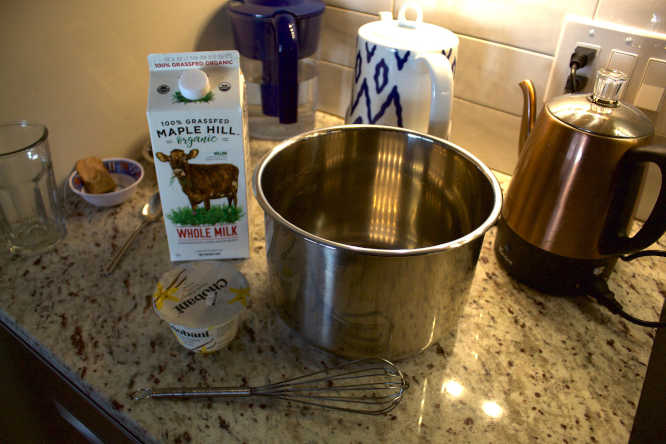
It’s easy to make absolutely perfect yogurt at home in large quantities while saving money and preventing waste. The yogurt we make at home is superior to commercial yogurt, is absolutely delicious, and is simple and easy to make. We also avoid nearly all of the plastic containers of commercial yogurt. I make a half gallon of yogurt every week, and it costs me only slightly more than a half gallon of milk.
Because we are making our own yogurt, we also have much more control over the choice of the milk used. Each time we make yogurt, we save about $1.80, and avoid the use of two large 32 oz. plastic containers. We do use an InstantPot computerized cooker for the process, but we strongly recommend the InstantPot because it has high energy efficiency, and can be used to conveniently and rapidly make rice, stew, soup, oatmeal, chili and many other dishes. Therefore we will not include the cost of the InstantPot in our cost calculations.
Less Than Three Minutes of Your Time Required

The process is not inconvenient or time consuming in any way. It takes less than two minutes to prepare the yogurt for incubation, and then another minute or so to pour it once it’s done into a large container for storage in the fridge. Incubation time is ten hours, with no supervision or tending necessary. The InstantPot will let you know when the yogurt is done.
The Quality Of The Yogurt

The yogurt we make is of exquisite quality. It is smooth and creamy, does not separate, and is thick but pourable. We find all these qualities to be absolutely ideal. To consistently produce absolutely ideal yogurt did take a bit of experimenting with both different kinds of milk, and different kinds of yogurt starter. Some of our first attempts produced yogurt that separated, so that every time we wanted to serve yogurt we had to stir it first, which is annoying, and also yogurt that did not taste as good as the perfect yogurt we now make every week.
You may have to experiment with types of milk and types of starter, but we know you can’t go wrong with organic homogenized pasteurized milk and Chobani Greek yogurt starter.
Summary Of The Process
Buy a half gallon of milk of your choice. We use organic grass-fed pasteurized and homogenized milk from Maple Hill Farms, and usually buy through Stop & Shop here in Cape Cod.
Buy a small container of yogurt of your choice to use as starter. We use a 5.3 ounce container of Chobani Greek yogurt, and use less than half of that small container as the starter.
Pour the half gallon of milk into the stainless steel pot of the InstantPot.
Add about a tablespoon of the yogurt starter.
Use a whisk to blend the starter into the milk.
Put the pot back in the InstantPot, and select the “yogurt” setting.
Ten hours later, transfer the yogurt to a container of your choice to keep in your fridge.
We use a half gallon glass jar for keeping the yogurt in the fridge because we prefer to minimize contact with plastic for all of our food and want to minimize our use of plastic in general.
Saving Money
You will always save money making yogurt this way, but how much you save per batch depends on the choice of milk you use, to a small degree on the type of starter you use, and also on what type of yogurt you use as a comparison. Here is our calculation of savings for our choices:
Half Gallon Maple Hill organic grass fed whole milk: $4.99
Chobani 5.3 ounce Greek starter: $1.59
Each batch of yogurt therefore costs us $4.99 + $.80 (1/2 of the small container of starter): $5.79
Compare this to buying two 32 oz. containers of organic yogurt, Stonyfield brand:
$3.50 x 2 = $7.00
Savings: $7.00 – $5.79 = $1.80
If you make a half gallon of yogurt per week, as we do, that’s 52 x $1.80 = $93.60 per year. In ten years you would save $930.
Avoiding Plastic
With each batch of a half gallon of yogurt we make, we avoid buying two 32 oz. plastic containers of commercial yogurt. This savings of resources is offset by buying milk in a cardboard half gallon container, and a small plastic 8 oz. container for the yogurt starter. Because of this offset, a rough estimate (though it’s difficult to compare savings between cardboard and plastic) is about 1.5 32 oz. plastic containers per half gallon batch of yogurt.
Savings for one year: 52 x 1.5 = 78 32 oz plastic containers avoid
Savings for ten years: 780 32 oz plastic containers avoided
If 1,000 people do this for ten years: 780,000 32 oz. plastic containers avoided
If 1 million people do this for ten years: 780 million 32 oz. plastic containers avoided